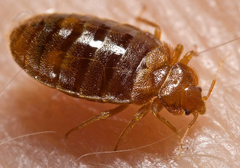APC ALPINE PEST CONTROL Bed Bugs
 Bed bugs are insects. Cimex lectularius is the species most commonly found in homes. Adult bed bugs have oval-shaped bodies with no wings. Prior to feeding, they are about 1/4 inch long and flat as paper. After feeding, they turn dark red and become bloated. Eggs are whitish, pear-shaped and about the size of a pinhead. Clusters of 10-50 eggs can be found in cracks and crevices.
Bed bugs are insects. Cimex lectularius is the species most commonly found in homes. Adult bed bugs have oval-shaped bodies with no wings. Prior to feeding, they are about 1/4 inch long and flat as paper. After feeding, they turn dark red and become bloated. Eggs are whitish, pear-shaped and about the size of a pinhead. Clusters of 10-50 eggs can be found in cracks and crevices.
Bed bugs have a one-year life span during which time a female can lay 200-400 eggs depending on food supply and temperature. Eggs hatch in about 10 days.
There are currently no known cases of disease associated with bed bug bites. Most people are not aware that they have been bitten. People who are more sensitive to the bite can have localized allergic reactions. Scratching the bitten areas may lead to infection.
What do bed bugs feed on?
 Bed bugs prefer to feed on human blood, but will also bite mammals and birds. Bed bugs bite at night, and will bite all over a human body, especially around the face, neck, upper torso, arms and hands. Bed bugs can survive up to six months without feeding. Both male and female bed bugs bite.
Bed bugs prefer to feed on human blood, but will also bite mammals and birds. Bed bugs bite at night, and will bite all over a human body, especially around the face, neck, upper torso, arms and hands. Bed bugs can survive up to six months without feeding. Both male and female bed bugs bite.
How do bed bugs get into my home?
Bed bugs are often carried into a home on objects such as furniture and clothing.
Bed bugs can be found in areas such as:
- Seams, creases, tufts and folds of mattresses and box springs
- Cracks in the bed frame and head board Under chairs, couches, beds, dust covers
- Between the cushions of couches and chairs
- Under area rugs and the edges of carpets
- Between the folds of curtains
- In drawers
- Behind baseboards, and around window and door casings
- Behind electrical plates and under loose wallpaper, paintings and posters
- In cracks in plaster
- In telephones, radios, and clocks
Bed bugs can also travel from apartment to apartment along pipes, electrical wiring and other openings.
